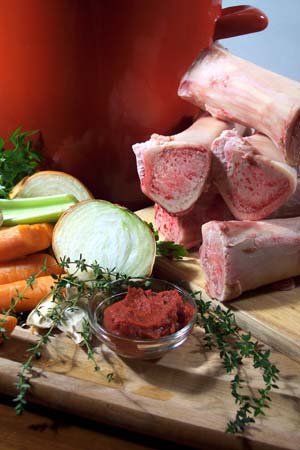
Though preparing beef stock from scratch is time-consuming, it’s not at all difficult or stressful. In fact, it’s positively soothing to casually tend a simmering pot throughout the day, letting your house fill with its heavenly aroma. Plus, the flavor benefits of homemade stock are undeniable!

| 6–7 | pounds | beef bones, 3–4 inches long |
| 2 | medium | onions, peeled |
| 3 | carrots | |
| 3 | stalks | celery |
| 4 | cloves | garlic |
| 2 | tablespoons | tomato paste |
| 16 | cups | cold water |
| 20 | black peppercorns | |
| 1 | whole bay leaf | |
| 1 | sprig | thyme |
| 10 | stems | Italian parsley |
| . |
Pre-heat oven to 450°
1. Run cold water over the bones to remove any imperfections; pat dry.
2. Put the bones in a large, heavy-bottomed roasting pan, being careful not to let them touch each other. Roast them in the oven for 40 minutes, turning the bones over halfway through cooking.
3. While the bones are roasting, prep the vegetables: Cut the onions in half, and slice the carrots and celery into large pieces about 3–4 inches long. Cut the top of the garlic bulb off to expose the individual cloves. Set aside.
4. Remove the bones from the oven and use your fingers or a pastry brush to dot them with the tomato paste. Add the vegetables to the pan and return to the oven. Roast for an additional 20 minutes, stirring once to turn everything over halfway through cooking.
5. Place the cold water in a large, heavy-bottomed stockpot and add the roasted bones and vegetables, peppercorns, bay leaf, thyme, and parsley.
6. Turn the heat to medium-high and bring to a lively simmer, skimming off the scum that rises to the top. Do not allow the stock to boil, or it will become cloudy.
7. Place the roasting pan used for the bones on top of the stove over a medium-high flame and heat until very hot. Deglaze the pan by pouring in one cup of water. Use a flat-edged wooden utensil to scrape all of the fawn—browned bits of flavor—from the bottom of the pan. Strain this liquid and add it to the stock.
7. Maintain a consistent simmer for 8–10 hours and continue skimming any scum. You’ll notice that most of the scum rises during the beginning of the cooking process with very little later.
8. Remove the bones and vegetables, then strain the stock through a large, fine mesh strainer—or a colander lined with cheesecloth—into a large, heat-resistant bowl.
9. Cool the stock to room temperature, then cover and refrigerate overnight.
10. Remove the fat that has risen to the top and solidified.
11. For convenient storage, freeze stock in small portions in ice cube trays or zip-lock bags, then thaw just what you need for everyday use.


